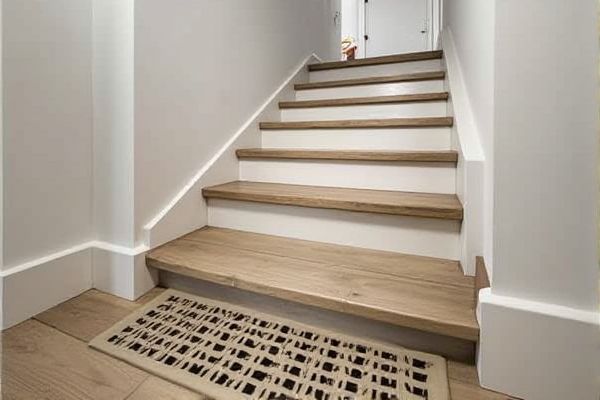
Perforated stair treads offer enhanced slip resistance and drainage, making them ideal for outdoor or industrial settings where safety and water runoff are critical, while solid treads provide a smoother, more traditional surface often preferred for interior applications and aesthetic appeal. Discover how your choice between perforated and solid treads can impact safety, durability, and design by reading the full article.
Table of Comparison
| Feature | Perforated Stair Treads | Solid Stair Treads |
|---|---|---|
| Material | Metal (Steel, Aluminum) | Wood, Metal, Concrete |
| Slip Resistance | High - Enhanced grip due to perforations | Varies - May require additional treatments |
| Drainage | Excellent - Water and debris pass through | Poor - Water accumulates on surface |
| Weight | Lighter due to perforations | Heavier and more solid |
| Maintenance | Easy - Less dirt accumulation | More frequent cleaning needed |
| Aesthetic | Industrial and modern look | Classic and solid appearance |
| Cost | Moderate to High - Depends on material and design | Varies - Often similar or lower cost |
| Applications | Outdoor, industrial, high-traffic areas | Indoor, residential, decorative uses |
Introduction to Stair Treads: Perforated vs Solid
Perforated stair treads offer enhanced slip resistance and improved drainage due to their open patterns, making them ideal for industrial and outdoor environments where safety and water runoff are critical. Solid stair treads provide a more uniform surface that supports aesthetics and ease of cleaning, commonly used in residential and commercial interiors for a sleek, seamless appearance. Choosing between perforated and solid treads depends on factors such as safety requirements, environmental exposure, and maintenance preferences.
Design and Aesthetics Comparison
Perforated stair treads offer a modern, industrial aesthetic with enhanced transparency and light diffusion, creating an open and airy staircase design. Solid treads provide a classic, robust appearance with clean lines and a uniform surface that complements traditional or minimalist interiors. The choice between perforated and solid treads significantly impacts stairway visual appeal, influencing both design style and spatial perception.
Slip Resistance and Safety Features
Perforated stair treads offer superior slip resistance due to their open patterns that allow water, debris, and grease to pass through, minimizing slippery surfaces and enhancing safety in wet or industrial environments. Solid treads, while durable, can accumulate moisture or dirt, increasing the risk of slips without additional anti-slip treatments. Safety features such as anti-slip coatings or abrasive strips are often necessary for solid treads, whereas perforated designs inherently provide better traction and drainage.
Durability and Lifespan Analysis
Perforated stair treads offer enhanced durability by providing superior slip resistance and improved drainage, reducing wear caused by water and debris accumulation, which extends their lifespan in industrial and outdoor environments. Solid treads, while often made from robust materials like steel or hardwood, may be more susceptible to surface wear and potential damage from trapped moisture, impacting their long-term durability. Your choice between perforated and solid stair treads should weigh the specific environmental conditions and maintenance requirements to ensure optimal lifespan and safety.
Maintenance and Cleaning Requirements
Perforated stair treads require less frequent cleaning as dirt and debris fall through the holes, reducing accumulation and the need for manual sweeping. Solid treads tend to trap dust and liquids on the surface, necessitating more regular and intensive maintenance to prevent slipping hazards and surface damage. Choosing perforated designs can enhance safety by minimizing buildup and simplifying routine cleaning protocols.
Weight and Load-Bearing Capacity
Perforated stair treads offer reduced weight compared to solid treads, making them easier to handle and install while maintaining sufficient structural integrity. Solid stair treads typically provide higher load-bearing capacity due to their continuous material, supporting heavier weights and higher traffic demands. Choosing between perforated and solid treads depends on the specific application, balancing weight-saving advantages with required strength and durability.
Weather Resistance and Outdoor Suitability
Perforated stair treads excel in weather resistance due to their ability to drain water and prevent accumulation, reducing the risk of slipping and corrosion in outdoor environments. Solid treads, while often sturdier, can trap water and debris, leading to faster deterioration and less reliable traction under wet conditions. Choosing perforated treads enhances your outdoor stair safety and durability by ensuring better drainage and resistance to weather-related wear.
Cost Comparison: Perforated vs Solid Treads
Perforated stair treads generally cost more upfront than solid treads due to the manufacturing process involving precise cutting and materials designed for enhanced slip resistance. Solid treads tend to be less expensive but may require additional treatments or coatings to meet safety standards, potentially increasing long-term expenses. When factoring in durability, maintenance, and safety compliance, perforated treads often represent a better value despite higher initial costs.
Installation Process and Flexibility
Perforated stair treads offer a quicker installation process due to their lighter weight and built-in drainage, making them ideal for environments requiring frequent adjustments. Solid treads provide more stability and sound insulation but typically demand more precise measurements and longer installation times. Your choice depends on the need for flexibility versus durability in the staircase design.
Choosing the Right Stair Tread for Your Project
Perforated stair treads offer enhanced slip resistance and drainage, making them ideal for outdoor or industrial environments where safety and weather exposure are concerns. Solid stair treads provide a sleek, durable surface suited for indoor settings, delivering a clean aesthetic and easier maintenance. When choosing the right stair tread for your project, consider factors such as location, usage, safety requirements, and aesthetic preferences to ensure optimal performance and compliance.
 homyna.com
homyna.com